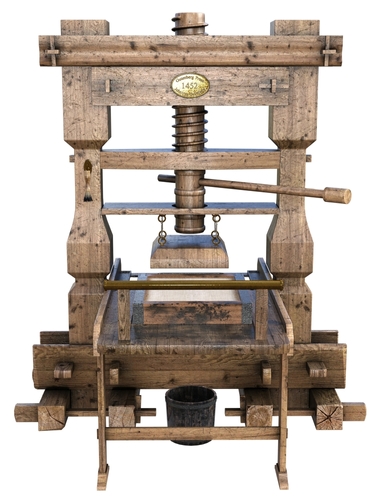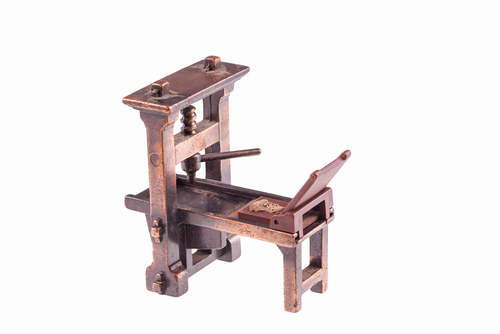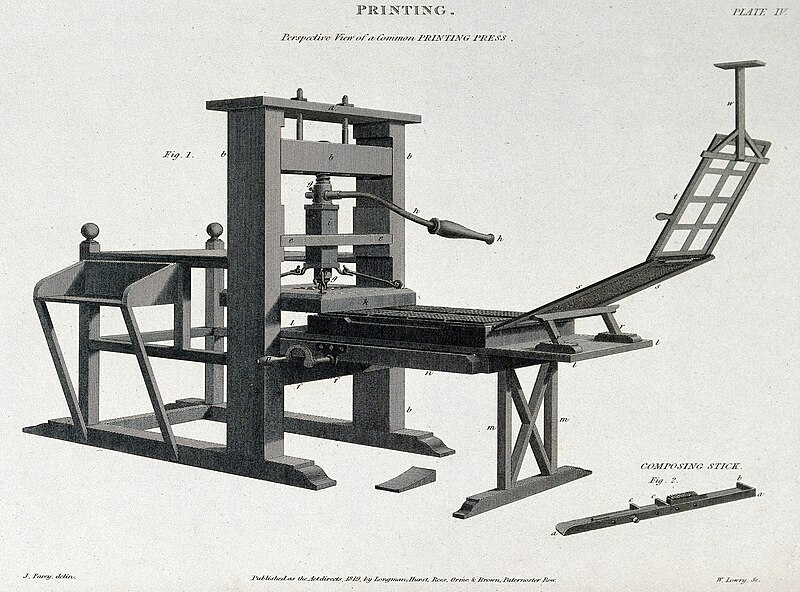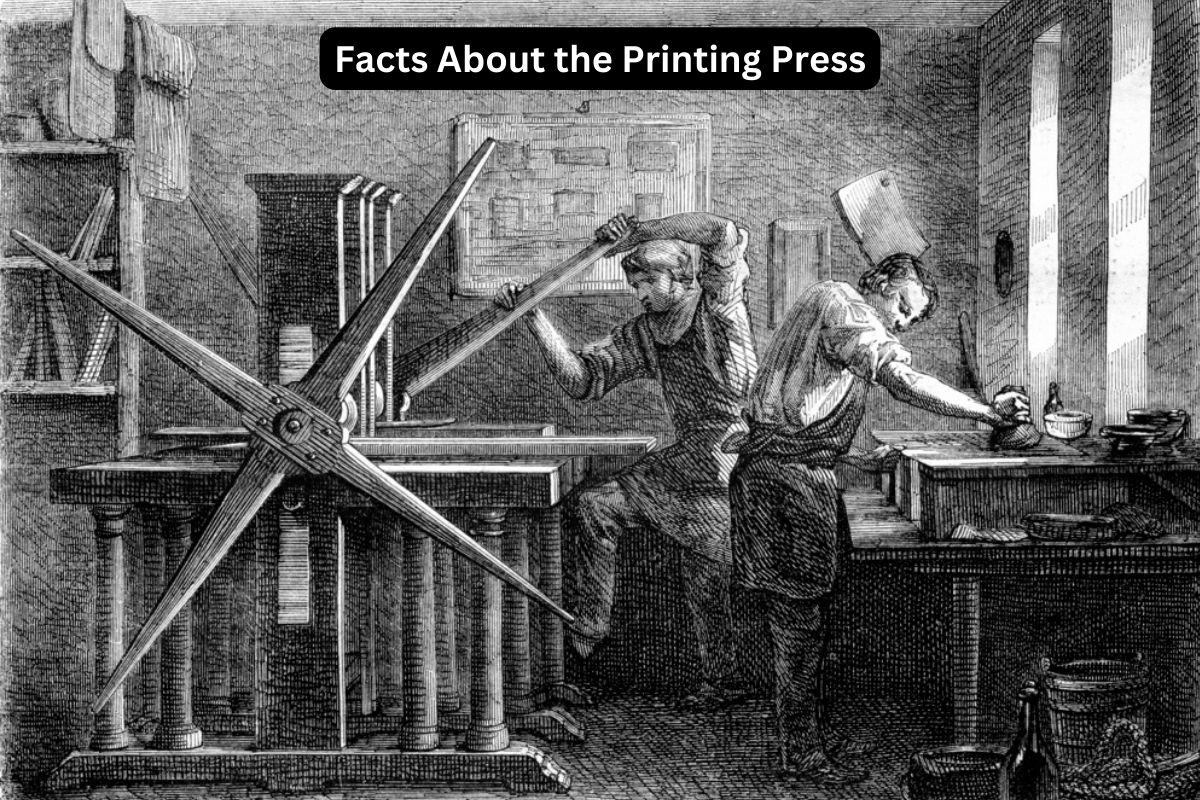The printing press, one of the most transformative inventions in human history, was pioneered by Johannes Gutenberg in the 15th century.
This ingenious device, employing movable type, revolutionized the way information was disseminated.
Its impact, known as the Printing Revolution, democratized knowledge, boosted literacy, and facilitated the rapid spread of ideas, contributing to cultural, social, and educational advancements that continue to shape the modern world.
In this introduction, we will delve deeper into the origins, mechanics, and profound effects of the printing press on human civilization.
Printing Press Facts
1. Invented by Johannes Gutenberg in 1440
Johannes Gutenberg, a German blacksmith, goldsmith, printer, and inventor, is credited with the invention of the printing press.
Also Read: Timeline of the Printing Press
He developed this revolutionary technology in the 15th century, specifically around 1440 in Mainz, Germany. Gutenberg’s innovation marked a significant turning point in the history of communication and the dissemination of knowledge.

2. Introduced movable type for efficient printing
Gutenberg’s key contribution to printing technology was the development of movable type. Before Gutenberg’s press, books and documents were painstakingly copied by hand, which was a slow and labor-intensive process.
Also Read: Johannes Gutenberg Timeline
Gutenberg’s movable type system involved individual metal or wooden letters and characters that could be arranged and rearranged to compose different texts. This innovation greatly accelerated the printing process, making it more efficient and cost-effective.
Gutenberg’s movable type system laid the foundation for modern printing methods, as it allowed for the rapid production of multiple copies of a text, something that was previously unthinkable.
3. First major work printed was the Gutenberg Bible
The Gutenberg Bible, also known as the 42-line Bible or the Mazarin Bible, was one of the first major works produced using Gutenberg’s printing press technology. This monumental achievement in printing occurred around 1455.
The Gutenberg Bible is renowned for its craftsmanship and historical significance. It consists of two volumes and is considered one of the most valuable and important books in the history of printing.
It played a vital role in demonstrating the capabilities of the printing press and showcased the potential for mass-producing books, which was a revolutionary concept at the time.
4. Triggered the Printing Revolution
The advent of the printing press by Johannes Gutenberg triggered what is commonly referred to as the “Printing Revolution.”
This period, which began in the mid-15th century, was characterized by a profound transformation in the way information was produced, disseminated, and consumed. Prior to the printing press, books and documents were primarily copied by scribes, which was a slow and expensive process.
Gutenberg’s press, with its movable type, made it possible to produce books more quickly and at a fraction of the cost. This led to an explosion of printed materials and a democratization of knowledge, as information became more accessible to a wider audience.

5. Increased accessibility to knowledge
One of the most significant impacts of the printing press was the increased accessibility to knowledge. Before the printing press, books were rare and expensive, primarily available to the clergy, aristocracy, and wealthy elites.
With the ability to mass-produce books, the cost of printed materials dropped significantly, making books more affordable to a broader range of people.
This democratization of knowledge led to higher literacy rates and expanded educational opportunities for the general population. It also played a pivotal role in the dissemination of scientific, religious, and philosophical ideas.
6. Diversified languages in printed materials
The printing press allowed for the publication of books and documents in various languages. Prior to its invention, Latin was the dominant language of written communication in Europe.
However, as printing presses spread across different regions, publishers began producing materials in local vernacular languages.
This helped preserve and promote regional cultures and languages. It also made literature, religious texts, and scientific knowledge more accessible to non-Latin-speaking populations.
The diversity of languages in printed materials contributed to the richness and complexity of European culture and laid the groundwork for the development of national literatures.
7. Enabled mass production of books
One of the most revolutionary aspects of the printing press was its ability to enable mass production of books. Before the press, each book had to be painstakingly copied by hand, which was a laborious and time-consuming process.
Gutenberg’s press, with its movable type and mechanical printing mechanism, made it possible to produce multiple copies of a text quickly and consistently. This transformation in book production drastically reduced the cost of books, making them more affordable and accessible to a broader audience.
As a result, the mass production of books became a hallmark of the Printing Revolution, and it laid the foundation for the modern publishing industry.

8. Boosted literacy rates in Europe
The increased availability and affordability of books, made possible by the printing press, had a significant impact on literacy rates in Europe.
Prior to the press, literacy was primarily confined to the clergy, nobility, and select scholars. With the widespread availability of printed materials, more people had the opportunity to learn how to read and write.
This led to a gradual increase in literacy rates across the continent as individuals sought to access and understand the wealth of knowledge contained in books. The printing press played a pivotal role in the spread of education and the development of a literate society.
9. Spread of printing technology worldwide
While Johannes Gutenberg’s press was a European invention, the concept of printing rapidly spread to other parts of the world. For example, the first known printing press in China was created around 868 CE, centuries before Gutenberg’s press.
The spread of printing technology had a profound impact on various cultures, allowing them to develop their own printing traditions and contribute to the dissemination of knowledge in their respective languages. The printing press played a key role in facilitating cross-cultural exchange and the global flow of ideas.
10. Considered one of history’s most important inventions
The printing press is widely regarded as one of the most important inventions in human history. Its influence on communication, education, culture, and the spread of ideas is immeasurable.
The Printing Revolution it initiated laid the groundwork for the modern information age. The ability to produce books and printed materials on a large scale transformed society, empowered individuals with knowledge, and fueled innovations in various fields.
Gutenberg’s invention continues to be celebrated for its enduring impact on human civilization and its role in shaping the course of history.
